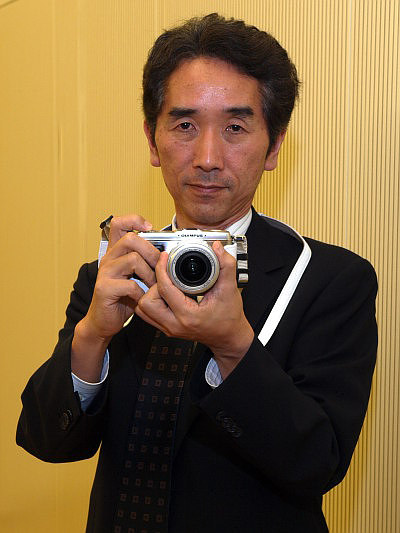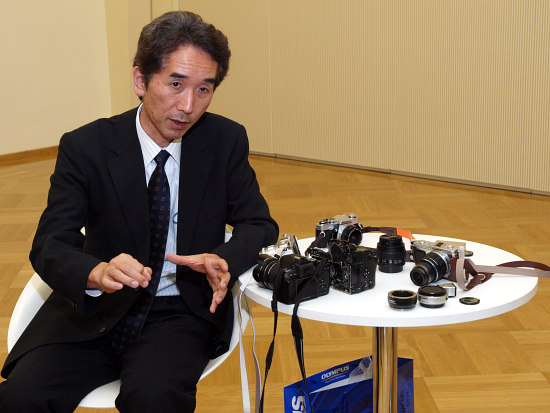 |
 ความคิดเห็นที่ 2
ความคิดเห็นที่ 2 |

KM:
The latest Olympus DSLRs have ''Art filters''.
Will these functions be further developed?
Are you planning to create more similar opportunities in this user niche than other companies?
AW:
We have many future candidates for the "Art Filters".
We chose the top 6 filters that we thought best for our customers,
and also preparing other filters to be incorporated in the future models.
We think this feature will be one of the key points for our system
and will keep on intensively developing new ones.
Last but not least we offer HD movie with art filters
which we think is a nice option for our customers
and makes the camera different from competition.
KM:
Olympus has declared an end to the megapixel race.
Does it mean we will have 12 MPix in Micro 4/3 for a long time?
Is there any chances we will see a lower megapixel range?
A matrix with 8-10 MPix could improve dynamic range,
reduce noise, increase speed and increase sensitivity.
Who decides on the amount of pixels?
AW:
I have not said we will stop the pixel race nor stop at 12M,
but I think pixel count is now less important than before,
since we have already exceeded 10M pixels
and satisfying most of the applications in terms of resolution that normal customers require.
We can not disclose what kind of sensors we are developing,
but will try to keep on improving them to meet customers' demands.
KM:
A question concerning the roadmap for lens development.
How many lenses for the Micro 4/3 will we see in the next 1-2 years?
AW:
We are planning a wide zoom and a high-mag zoom next spring.
For further plans,
we would like to inform the customers when it becomes possible.
KM:
Can we expect an increase in the number of fast fixed focal length lenses in the near future?
AW: Let us take that as a request.
KM:
The System 4/3 doesnt have an ultrawide zoom like 16-35 f/2.8 on FF.
In the Micro 4/3 is it easier or harder to develop this type of lens?
AW:
We have 7-14mm zoom which is equivelent to 14-28mm in 35mm film format in our 4/3 system.
Comparing the 4/3 system and the Micro 4/3 system,
generally speaking, the Micro 4/3 would be able to make a wide lenses smaller
because of its shorter flange back.
KM:
And the last questions about lenses.
How many ''pancakes'' in Micro 4/3 can be expected in the near future?
Will we see them also in normal 4/3 systems?
AW:
As to the lenses, what we can disclose at the moment are the above mentioned two zoom lenses in next spring,
and we are also planning a firmware upgrade of the 12-60 mm
and the 50-200 mm SWD to be capable of the high speed imager AF.
KM:
The new E-620 is certainly of interest to tourists.
It is a light and compact camera.
Can we expect a similar,
but more durable and tough version with dust and waterproof body?
AW: Let me take it as a request.
KM:
In conclusion,
Id like to ask about the Pro DSLR market and a future successor to the E-3.
Is Olympus planning two different versions of the E-3,
something like the Nikon D3 and D3x or Canon 1D and 1Ds?
The studio version of the E-3 could have 12 MPix or more and low sensitivity from ISO 25 to ISO 200-400,
while the reporter version E-3 could be faster,
have 8-10 MPix and higher sensitivity starting from ISO 200.
In this scenario, both cameras would have the optimum combination of quantity of pixels,
dynamic range and noise.
Is it too risky for Olympus to create such a solution?
Or maybe there are some technological problems?
AW:
With the E-3 and the E-30,
while the basic performance is the same for both,
we wanted to offer reliability and durability with the E-3
and the creativity with the E-30. For future models,
we will take the customers' advice and develop what we think is best for them.
Thank you for your advice.
KM: Thank you for the interview.
;-)
| จากคุณ |
:
บางคนเรียกผมว่า (lexusman) 
|
| เขียนเมื่อ |
:
3 ก.ย. 52 11:01:09
|
|
|
|
 |







